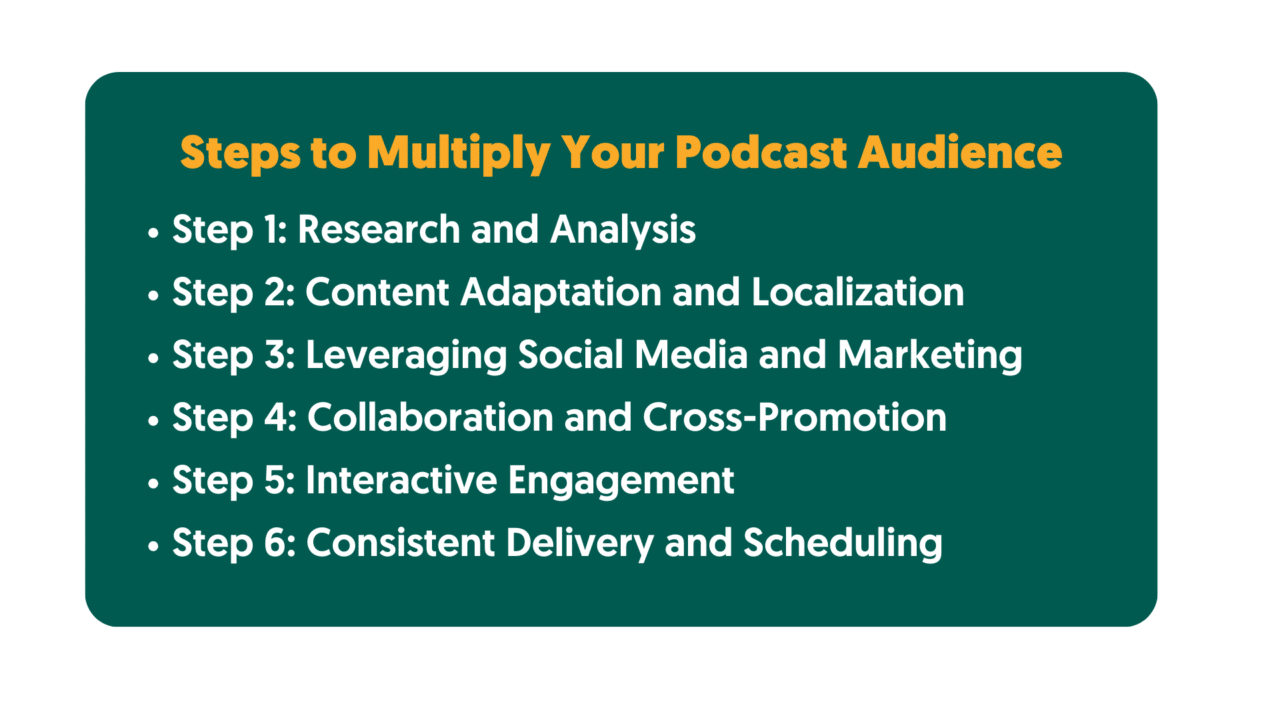In today’s globalized world, the power of the spoken word has transcended international boundaries, thanks to the rise of podcasts. This digital medium has revolutionized the way we consume information, offering a more personalized and engaging alternative to traditional broadcasting. However, while English remains the dominant language in podcasting, an untapped multilingual audience awaits. Could addressing this audience in their language multiply your podcast audience? The answer is yes!
Breaking the language barrier can open doors to a plethora of non-English speaking listeners, thereby expanding your reach and influence. Targeting a multilingual audience is not just about translations; it’s about creating a sense of community and inclusion, offering content that resonates with them culturally, and establishing meaningful connections. This blog post aims to guide you through multiplying your podcast audience beyond your native language. So, let’s embark on this exciting journey to explore the uncharted territories of multilingual podcasting.
Table of contents
Understanding the Benefits of Multilingual Podcasting
Before delving into the how-to’s of multilingual podcasting, let’s explore why it’s worth considering.
By going multilingual, you’re essentially unlocking the door to an audience base that far exceeds the English-speaking world. This expansion can dramatically increase your podcast’s reach and impact, and potentially catapult your podcast into global popularity.
Increased Diversity and Inclusivity
Multilingual podcasting invites diversity into your listener community, enriching it with varied cultural perspectives and experiences. This inclusive approach can help your podcast stand out, fostering a sense of belonging and connection among listeners from different linguistic backgrounds.
Opportunities for Collaborations and Partnerships
Embracing languages other than your own opens up a world of collaboration opportunities. From guesting non-English speaking influencers to partnering with foreign language podcasts, these collaborations can boost your podcast’s visibility and credibility in new markets.
Steps to Multiply Your Podcast Audience Beyond Your Native Language
Creating a multilingual podcast might seem daunting, but with strategic planning and implementation, you can effectively grow your audience in your targeted languages. Here are the six steps to aid you in this process.

Step 1: Research and Analysis
The first step is to identify which languages to target. You can do this by researching popular podcast languages, countries with high podcast consumption, and the languages spoken by your existing listeners. Understanding the cultural nuances and preferences of your target audience can help tailor your content to their tastes. Cultural insights can also guide your podcast format, theme, and topic choices.
Step 2: Content Adaptation and Localization
Translating your episode titles and descriptions is a crucial step. It not only makes your podcast accessible but also boosts visibility in foreign language search results. Content localization goes beyond literal translation. It involves adapting your content to fit the cultural, societal, and linguistic contexts of your target audience.
Keep an eye on trends and interests popular in the target language community. Incorporating these elements into your episodes can increase your podcast’s relevance and appeal.
Step 3: Leveraging Social Media and Marketing
Promote your podcast in multiple languages across various social media platforms. This will raise awareness and attract potential listeners who speak those languages. You should also consider engaging with communities and influencers who speak your target languages. They can help your podcast gain traction in these new markets. Finally, use relevant hashtags and keywords in your target languages in your social media posts. This will improve your podcast’s visibility and discoverability.
Step 4: Collaboration and Cross-Promotion
Collaborate with local influencers or other podcasters from your targeted language groups. This will expose your podcast to their follower base, increasing your audience. Network and participate in international podcast events and communities. These platforms provide opportunities for exposure and collaborations.
Don’t be scared to make guest appearances on popular foreign podcasts. This can help you tap into their listener base and attract new followers.
Step 5: Interactive Engagement
Create platforms where listeners can engage in their native language. This encourages interaction and fosters a sense of community. Encourage listeners to leave feedback and contribute in their language, as this can provide valuable insights to improve your multilingual podcast. Moreover, hosting live episodes or Q&A sessions in various languages can boost engagement. This also demonstrates your commitment to catering to a diverse audience.
Step 6: Consistent Delivery and Scheduling
Consistency is key in podcasting. Ensure you maintain a reliable podcasting schedule across all languages to keep your audience engaged. Don’t forget to take into account the time zone differences of your audience when releasing your episodes. Timing your release can maximize listenership in different regions!
How can you monetize your podcast?
Find out more now!Overcoming Challenges and Tips for Success
Multilingual podcasting can be a daunting task, and like any venture, it does have its challenges. Here are some common difficulties you might face and some tips on how to overcome them.
Language Barrier
The most obvious challenge is the language barrier. Not everyone is multilingual, and even if you are, there might be nuances in dialects and accents that could cause miscommunication.
Tip: Hire Native Speakers or Use Translation Services
Consider hiring native speakers or using professional translation services. Native speakers can provide accurate translations and offer insights into cultural nuances. Alternatively, there are numerous online translation services that offer high-quality translations at affordable prices.
Quality Consistency Across Different Languages
Ensuring a consistent quality of content across different languages can be difficult to manage. Sometimes, translation can lead to loss of meaning, and cultural differences might make some content irrelevant in certain languages.
Tip: Regular Audits and Feedback Collection
To address this, conduct regular content audits and collect feedback from your listeners. These practices can help ensure that your content remains relevant and engaging across different languages.
Technical Challenges
Producing a podcast in multiple languages can bring about technical complexities. You may need to manage different feeds, and SEO can become a challenge when dealing with multiple languages.
Tip: Use Multilingual Podcast Hosting Platforms
There are several multilingual podcast hosting platforms available that can help manage your different podcast feeds. Also, learning the basics of multilingual SEO can greatly improve your podcast’s visibility across different languages.
Cultural Misunderstanding
When producing content for diverse audiences, there’s always a risk of cultural misunderstanding or offensive content, even if unintentional.
Tip: Cultural Sensitivity and Extensive Research
Ensure you invest time in understanding the culture of your target audience. Extensive research and consultation with cultural experts can help avoid potential cultural misunderstandings.
Remember, the goal of a multilingual podcast is not just to multiply your audience but also to create a global community where everyone feels included and respected. By addressing these challenges head-on and with sensitivity, you can reap the benefits of a truly international podcast.
Case Studies: Successful Multilingual Podcasting Examples
Let’s take a look at some successful multilingual podcasting examples to inspire your journey.
Case 1: Duolingo Spanish Podcast
The Duolingo Spanish Podcast is an excellent example of a podcast that effectively reaches a multilingual audience. Providing captivating stories in easy-to-understand Spanish, the podcast is designed for Spanish learners who want to improve their listening comprehension. The success of this format led Duolingo to develop similar podcasts for other languages.
Case 2: News in Slow French
News in Slow French is a podcast that presents global news in slow, clear French. It’s a great resource for French learners and has been highly successful due to its unique approach in engaging its audience. The creators of News in Slow French have launched similar podcasts in other languages, indicating the success of their multilingual approach.
Case 3: Radiolingua Network
The podcasts from the Radiolingua Network, including the popular Coffee Break Spanish and Coffee Break French series, provide language-learning content in several languages. With a broad range of content, from beginner lessons to advanced courses, these podcasts have garnered a global audience and demonstrate the potential of multilingual podcasting.
These case studies exemplify the power of multilingual podcasting. With the right strategies and commitment to quality, your podcast too can reach audiences far beyond your native language.
Tools and Resources for Multilingual Podcasting
Embarking on the journey of multilingual podcasting is made easier with the right tools and resources. Here are some options you might find useful.
Translation Services
- Google Translate: While not perfect, Google Translate can provide quick translations for less complex text. It’s a good starting point before moving onto more accurate resources.
- Deepl: Deepl is recognized for its superior translation quality. It’s a great tool for translating scripts or episode descriptions.
- Amberscript: Make use of Amberscript’s expert translators and obtain quality translations for your podcast within hours! You can choose from 39 languages and explain your project in depth, so you are sure you get the best service possible.

Receive a custom offer
Tell us about your translation needs
Oops! We could not locate your form.
Podcast Hosting Platforms
- Soundcloud: Soundcloud is a popular podcast hosting platform that supports multiple languages. It’s an excellent tool for distributing your multilingual podcast.
- Libsyn: Another leading podcast hosting platform, Libsyn offers robust features and supports various languages, ideal for a multilingual podcast.
Audio Editing Software
- Audacity: This is a free, open-source audio editing software suitable for both beginners and professionals. It’s available in several languages.
- Adobe Audition: This is a professional-grade audio editing tool. Although paid, it offers comprehensive features and multi-language support.
Transcription Services
If you are looking for the right transcription service, you are in luck: Amberscript can definitely help you! Wether you choose the automatic or professional transcription service, you can rest assured that everything will be taken for for you. When you choose automatic transcription, our cutting-edge AI technology will transcribe your audio and video files quickly and with up to 85% accuracy. Once you get the file back (within minutes, saving you lots of time), you can edit the transcript as much as you want.
If you opt for our human-made service, one of our professional transcribers will meticulously take care of the revision process, assuring up to 100% accuracy for your file. Moreover, Amberscript’s user-friendly platform makes the entire process seamless, from uploading files to receiving the final transcripts. With the blend of automation and human expertise, Amberscript truly offers a comprehensive transcription solution that caters to diverse transcription needs, making it the top choice in the industry.
In conclusion, these tools and resources can significantly aid in your multilingual podcasting journey by offering services that help you produce, manage, and distribute your podcast in various languages.
Embarking on the multilingual podcasting journey can be an enriching experience that goes beyond merely expanding your audience. It enables you to connect with different cultures, learn new perspectives, and truly create a global community through your content. Remember, the challenges are surmountable with the right strategies, tools, and resources. Don’t let language boundaries limit the reach of your podcast.
Call to Action: Start Your Multilingual Podcast Today
It’s time to take your podcast beyond your native language. Start today! Whether you’re just starting out or already have an established podcast, there are resources available to assist you. Make use of the tools and strategies discussed in this post, learn from successful multilingual podcast examples, and begin to multiply your audience. Don’t forget to share your experiences and successes with us. We can’t wait to see how far your podcast will go!